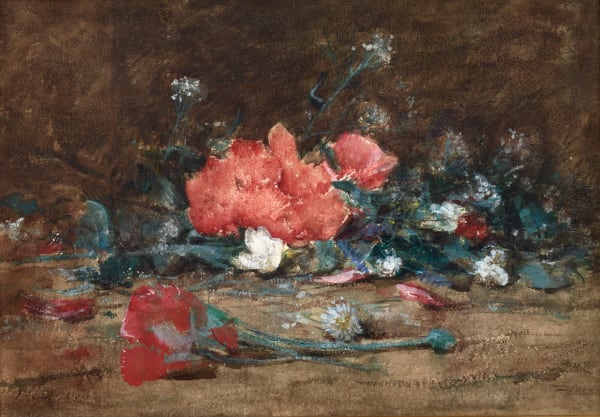J. Alden Weir 1852-1919
Weir was raised in a humble environment, yet one richly steeped in culture. He studied the enormous collection of prints and books that his father had acquired in Italy in the late 1820s. In addition, his father introduced him to leading figures in the Hudson River School, including Thomas Cole, Asher B. Durand, and Frederic Church.
His half-brother, John Ferguson Weir, also expanded his artistic horizons. When John traveled to Europe from 1868 to 1872, he let his younger sibling stay in his studio in New York’s Tenth Street Studio Building, home to many of the leading artists of the day. J.A. Weir enhanced his own worldliness in European study and travel. From 1873 through 1877, he lived in Paris, where he was a favorite student of Jean Léon Gérôme at the Ecole des Beaux Arts. He also received instruction privately from Gustave Boulanger and attended the Gratuite de Dessin (the Petite Ecole), where he drew from life and the Antique and studied sculpture with Amédee Faure and Aimé Millet. In the summers, he painted in Brittany and traveled to Holland, Belgium, Spain, and London, where he visited James McNeill Whistler.
In 1883, Weir married Anna Baker, and the couple had a long honeymoon in Europe. Between April and September 1883, they visited Paris, Stuttgart, Nuremberg, Munich, Tyrol, Venice, Dordrecht, and The Hague. On a trip to London, Weir acted on behalf of the banker and philanthropist Henry Gurdon Marquand, purchasing paintings for the latter’s collection, including a work by Rembrandt.
From Paris, Weir wrote to his brother John, expressing his feeling that as a married man, it was time for him to return home, where the “main stay” of his life might be “found better.” He planned to “hammer at portraits” to make a living. Accordingly, the Weirs returned to America in September of 1883, settling into a tiny New York apartment at 31 West 10th Street. On March 24, 1884, they welcomed their first child, Caroline Alden Weir, whom they called Caro.
Although Weir had expected to support himself from portraiture on returning from his honeymoon, the growing popularity of artistic photography made it difficult for him to obtain portrait commissions, and he therefore relied on the salary he received from teaching art classes at Cooper Union and the Art Students League. After selling his large allegorical canvas, The Muse of Music (1881–1884, private collection) in 1884, the family spent the summer in the farmhouse in Branchville, Connecticut, that Weir had purchased in 1882. At the end of the year, they returned to the city, where Weir focused his efforts on painting those close to him, especially Anna and Caro, in lieu of portrait commissions. These paintings, often large-scale works, show the progression from Weir’s earlier academic approach to a more progressive painting style.
In the early 1890s, Weir began to adopt fully the Impressionist painting style, which suited his growing interest in depicting landscapes. He was soon considered a leading member of the new Impressionist group of painters emerging in America at that time. In 1898, he became one of the founding members of The Ten, which was a group including Childe Hassam, Willard Metcalf and John Henry Twachtman, among others. His homes at Branchville and Windham provided endless inspiration for his lyrical landscapes made up of loose brushwork and pale colors, often shades of blue, yellow, and green. This period from 1900 until his death in 1919 brought the artist his greatest success and recognition.

